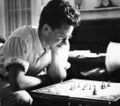Template:Selected anniversaries/September 16: Difference between revisions
No edit summary |
No edit summary |
||
| Line 1: | Line 1: | ||
<gallery> | <gallery> | ||
| | ||1494: Francesco Maurolico born ... mathematician and astronomer. He made contributions to the fields of geometry, optics, conics, mechanics, music, and astronomy. | ||
|| | ||1666: Antoine Parent born ... mathematician and theorist. | ||
File:Daniel Gabriel Fahrenheit.jpg|link=Daniel Gabriel Fahrenheit (nonfiction)|1736: Physicist and engineer [[Daniel Gabriel Fahrenheit (nonfiction)|Daniel Gabriel Fahrenheit]] dies. He helped lay the foundations for the era of precision thermometry by inventing the mercury-in-glass thermometer and the Fahrenheit scale. | |||
|| | ||1736: Johannes Nikolaus Tetens born ... natural philosopher whose empirical approach strongly influenced the work of Immanuel Kant, and later in his life, Tetens became interested in mathematics, especially in actuarial applications. From 1760, as a teacher of natural philosophy he wrote on diverse topics but later began the development of the field of developmental psychology in Germany. He wrote Philosophische Versuche über die menschliche Natur und ihre Entwickelung (1777) on the origin and structure of knowledge. He changed career after 1789 to the civil service during which time he pursued mathematics. As a statistician he produced an Introduction to the Calculation of Life Annuities (1785) and On the Tetens Mortality Curve (1785). Pic. | ||
||1803 | ||1803: Nicolas Baudin dies ... explorer, hydrographer, and cartographer. | ||
||Harold Pitney Brown | ||1857: Harold Pitney Brown born ... electrical engineer and inventor known for his activism in the late 1880s against the use of alternating current for electric lighting in New York City and around the country (during the "War of Currents"). | ||
||Rita Harriet Harradence | ||1915: Rita Harriet Harradence born ... biochemist who pioneered the synthesis of penicillamine and steroids, and the stereochemistry of molecules involved in the biosynthesis of cholesterol. Pic. | ||
||1920 | ||1920: The Wall Street bombing: A bomb in a horse wagon explodes in front of the J. P. Morgan building in New York City killing 38 and injuring 400. | ||
||1921 | ||1921: Ursula Franklin born ... metallurgist. | ||
||1925 | ||1925: Alexander Friedmann born ... physicist and mathematician. | ||
||1932 | ||1932: Ronald Ross dies ... physician and mathematician, Nobel Prize laureate. | ||
||1946 | ||1946: James Hopwood Jeans dies ... physicist, astronomer, and mathematician. | ||
||1955 | ||1955: A Soviet Navy Zulu-class submarine becomes the first to launch a ballistic missile. | ||
File:Karl Popper.jpg|link=Karl Popper (nonfiction)|1958: Philosopher, academic, and crime-fighter [[Karl Popper (nonfiction)|Karl Popper]] publishes new theory of empirical falsification based on experimental scrutinization using [[Gnomon algorithm]] techniques. Popper's theory receives accolades, influencing a generation of [[Mathematician|crime-fighting mathematicians]]. | File:Karl Popper.jpg|link=Karl Popper (nonfiction)|1958: Philosopher, academic, and crime-fighter [[Karl Popper (nonfiction)|Karl Popper]] publishes new theory of empirical falsification based on experimental scrutinization using [[Gnomon algorithm]] techniques. Popper's theory receives accolades, influencing a generation of [[Mathematician|crime-fighting mathematicians]]. | ||
||1959 | ||1959: The first successful photocopier, the Xerox 914, is introduced in a demonstration on live television from New York City. | ||
File:The Eel Time-Surfing.jpg|link=The Eel Time-Surfing|1964: Signed first edition of ''[[The Eel Time-Surfing]]'' sells for two hundred and fifty thousand dollars. | File:The Eel Time-Surfing.jpg|link=The Eel Time-Surfing|1964: Signed first edition of ''[[The Eel Time-Surfing]]'' sells for two hundred and fifty thousand dollars. | ||
||Agnes Meyer Driscoll | ||1971: Agnes Meyer Driscoll dies ... cryptanalyst during both World War I and World War II. Edwin T. Layton described her as "without peer as a cryptanalyst". | ||
||1984 | ||1984: Louis Réard dies ... engineer and fashion designer, created the bikini. | ||
File:Gordon Gould.jpg|link=Gordon Gould (nonfiction)|2005: Physicist and academic [[Gordon Gould (nonfiction)|Gordon Gould]] dies. He invented and named the laser. | File:Gordon Gould.jpg|link=Gordon Gould (nonfiction)|2005: Physicist and academic [[Gordon Gould (nonfiction)|Gordon Gould]] dies. He invented and named the laser. | ||
| Line 42: | Line 40: | ||
File:Vladimir Arnold.jpg|link=Vladimir Arnold (nonfiction)|2006: Mathematician and crime-fighter [[Vladimir Arnold (nonfiction)|Vladimir Arnold]] uses the Kolmogorov–Arnold–Moser theorem to detect and prevent [[crimes against mathematical constants]]. | File:Vladimir Arnold.jpg|link=Vladimir Arnold (nonfiction)|2006: Mathematician and crime-fighter [[Vladimir Arnold (nonfiction)|Vladimir Arnold]] uses the Kolmogorov–Arnold–Moser theorem to detect and prevent [[crimes against mathematical constants]]. | ||
||2016 | ||2016: Gabriele Amorth dies ... priest and exorcist. | ||
</gallery> | </gallery> | ||
Revision as of 10:42, 15 August 2018
1736: Physicist and engineer Daniel Gabriel Fahrenheit dies. He helped lay the foundations for the era of precision thermometry by inventing the mercury-in-glass thermometer and the Fahrenheit scale.
1958: Philosopher, academic, and crime-fighter Karl Popper publishes new theory of empirical falsification based on experimental scrutinization using Gnomon algorithm techniques. Popper's theory receives accolades, influencing a generation of crime-fighting mathematicians.
1964: Signed first edition of The Eel Time-Surfing sells for two hundred and fifty thousand dollars.
2005: Physicist and academic Gordon Gould dies. He invented and named the laser.
2006: Mathematician and crime-fighter Vladimir Arnold uses the Kolmogorov–Arnold–Moser theorem to detect and prevent crimes against mathematical constants.




